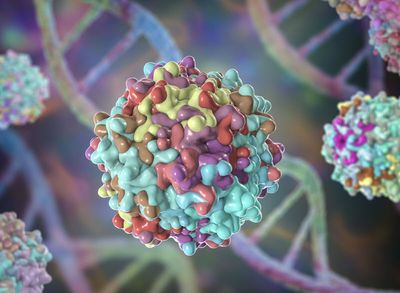
Rosa Bacchetta is an associate professor of pediatrics at Stanford University. Her goal as a physician-scientist is to use modern technologies in the laboratory to find cures for untreatable pediatric diseases. Bacchetta’s primary focus has been the rare autoimmune disorder IPEX syndrome, short for immune dysregulation, polyendocrinopathy, enteropathy, X-linked syndrome. In this disorder, a mutation in the critical transcription factor gene forkhead box P3 (FOXP3) causes regulatory T cell dysfunction. The result is a collection of unwanted immune reactions appearing in infancy against a person’s own tissues.
Shortly after researchers identified the connection between FOXP3, regulatory T cells, and IPEX syndrome, Bacchetta began treating the disorder with allogenic stem cell transplants that use donor cells. Twenty years later, she innovates IPEX treatments using gene therapy strategies that edit the mutated FOXP3 in patients’ own immune and stem cells.
What inspired you to become a physician-scientist?
Medicine and research were always linked for me; I loved pediatrics and I was interested in immunology. As a physician, I understood the frustration of giving a medication that may cure symptoms but not a disease’s cause. That is what led me to research. Working in pediatrics, I saw a lot of patients with rare diseases. We must understand the mechanisms of these diseases—how mutations can lead to devastating diseases—and find cures for them.
What is the clinical outlook for patients with IPEX syndrome and what treatment options currently exist?
These kids are born with severe autoimmune diseases that affect many areas including the gut, skin, pancreas, nervous system, kidneys, and blood. This disease greatly affects patients’ quality of life because they need continuous medication and their symptoms worsen throughout the years.
A common treatment for the symptoms—but not the cause—is pharmacological immunosuppression. This treatment suppresses the undesired immune reaction against their own tissues, but it also suppresses the immune reaction against pathogens. In the long run, these medications have many side effects, they lead to chronic infections, and they are not strong enough to prevent the disease from worsening. The alternative is to completely replace the immune system. This is done through hematopoietic stem cell transplantation with cells from an allogenic donor. Although it has been shown to be curative, this strategy has a lot of problems, including the need for compatibility between the donor and the recipient. The patient needs to take many medications to wipe out their cells prior to transplantation, and after that there is a chance of rejection due to graft versus host disease.
You are working on two new treatments for IPEX that use a patient’s own cells rather than donor cells. How do these therapies work?
Regulatory T cell therapy is similar to the strategy used in CAR T cell therapy for cancer. We take a patient’s lymphocytes and add a normal FOXP3 gene under a constitutive promoter so that these cells become regulatory T cells. After we grow a population of these cells, we return them to the patient. I think this could be a very good alternative to pharmacological immunosuppression. We have a clinical trial for this autologous gene therapy and we have already treated two patients.
The ideal therapy is to correct the gene mutation in a patient’s stem cells, rather than their existing lymphocytes. The edited stem cells can then continuously generate new immune cells, including regulatory T cells, within the patient. A couple of years ago, Matthew Porteus, my colleague at Stanford University, and I published a paper on the feasibility of using CRISPR gene editing to fix the FOXP3 mutation in cells from IPEX patients. In the regulatory T cell approach, the corrected gene is always highly expressed. In the stem cells, we need to preserve the complex regulation of the FOXP3 transcription factor so that when different immune cells form, each will have the proper gene expression depending on the cell type and the immune system’s activation status. I hope that what we are working on right now will be the ideal strategy for curing these patients.
What is your outlook on using CRISPR to edit stem cells for gene therapy?
The fact that you can modify a precise site within a gene makes CRISPR an extremely fascinating and promising technology, and there are new techniques coming out that can improve it further. For example, the possibility of editing without making a double-stranded DNA break will help prevent the potential introduction of new mutations in the edited cells.
When it comes to gene therapy, what we learn from one disease can be applied to others, but then each situation is specific. Each gene and its mechanism of action should be taken into consideration when developing a gene therapy. That is why a gene therapy should be developed by scientists that know the gene and the disease very well.
This interview has been condensed and edited for clarity.






